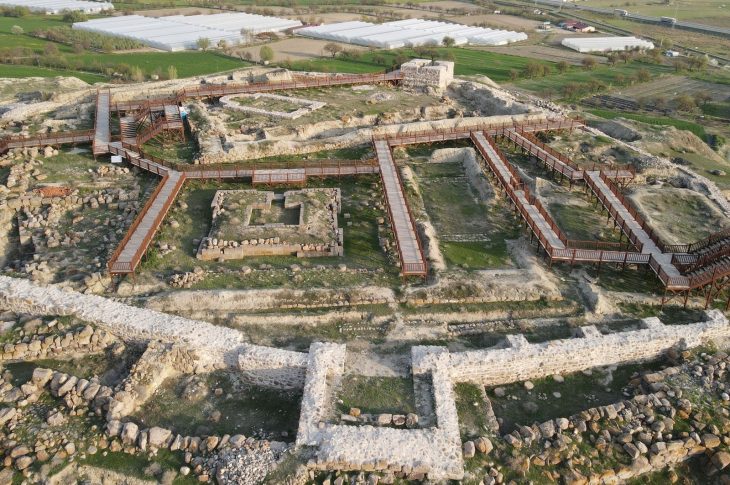Hidden deep in the northern Ontario wilderness, an extraordinary archeological discovery has puzzled researchers and captured the imagination of history enthusiasts. A fallen tree near the town of Wawa uncovered a mysterious rock carving that has now been identified as the longest runic inscription in North America — and the only one known worldwide to contain the full Lord’s Prayer.
Roughly seven years ago, a fallen tree near exposed a remarkable carving etched into the bedrock: 255 runic symbols arranged in a rectangular shape, measuring about 1.2 by 1.5 metres. Accompanying the runes was a detailed depiction of a boat carrying 16 figures, along with 14 “X” marks carved beside it.
The photos reached Ryan Primrose, President, and David Gadzala, Vice President, of the Ontario Centre for Archaeological Education. Following the discovery, Primrose and Gadzala initiated a systematic study of the site, marking the beginning of their multi-year research effort.
In an interview with CBC’s Erik White, Primrose shared his astonishment:
“It’s certainly among the least expected discoveries of my career. It’s absolutely fascinating.”
He has been studying the carvings since 2018 but chose to keep the discovery under wraps until he and his team could better understand its origins.
“We didn’t want to release anything publicly until we had done as much analysis as possible,” he explained to CBC’s Erik White.

Ancient Symbols, Modern Mystery
Primrose soon identified the characters as Nordic runes from the Futhark alphabet, used in Scandinavia for centuries. Concerned the discovery might be misinterpreted as a Viking relic, Primrose reached out to Dr. Henrik Williams, an internationally renowned runologist and emeritus professor at Uppsala University in Sweden.
Dr. Williams traveled to the site on a cold, rainy October day to examine the carvings in person.
“I was under a tarpaulin for three hours with a flashlight, looking at the runes while others were freezing outside,” he told CBC. “And I came out with this reading.”
In 2019, OCARE arranged a follow-up visit that brought Dr. Williams back to the site — this time with Loraine Jensen, President of the American Association for Runic Studies, as well as local historians and OCARE team members. During that October investigation, the group confirmed the authenticity of the runes: they were neither Viking-era nor a modern hoax.
Dr. Williams concluded the runes represent a Swedish-language version of the Lord’s Prayer, carved using a variation of the runic system developed by Johannes Bureus in the early 1600s. The wording closely matches the version of the prayer that was widely used in Sweden beginning in the 16th century.

In his official report, Williams underscored the rarity and historical significance of the find:
“Canada now has a total of eleven objects claimed to bear runes, but only five in fact do so, and three of those constitute modern commemorative inscriptions: the Gimli stone, the L’Anse aux Meadow stone (both in English), and the Vanier Park stone (probably in imitation Old Norse). There is a partial copy of a Swedish runic carving at Mahone Bay. The Wawa stone is Ontario’s first with actual runes, the longest runic inscription of any on the North American continent, and the only one in the world reproducing the Lord’s Prayer.”
“They are deeply carved—it must have taken someone days, maybe weeks. This was likely a Swede. But were there any Swedes here?”
A Swedish Connection
According to Primrose, historical records confirm that the Hudson’s Bay Company employed Swedish workers in the 1800s at trading posts throughout the Canadian wilderness, including the Michipicoten post, not far from the discovery site.
Based on the wear of the engraving and supporting documentation, Primrose’s current theory is that the carving was made in the early to mid-1800s.
While Williams expressed mild disappointment that the carving is only about 200 years old, he emphasized that the age doesn’t diminish the intrigue.

“The mystery doesn’t fade just because it’s younger than we hoped. Why was it carved here? Why this text? There are no answers. And mysteries always draw people in.”
Spiritual Site or Solitary Prayer?
Primrose speculates that the site could have served as a religious gathering place for Swedish traders or perhaps was the solitary devotional work of one individual. The carving was discovered under several inches of soil, possibly intentionally buried. No other artifacts were found nearby, leaving researchers with more questions than answers.
Working with the landowner, Primrose has applied for a leasehold and is actively seeking funding to turn the location into a heritage tourism site. Plans include a protective structure over the carving to preserve it for future generations.
He hopes to finalize development plans by the end of the summer and eventually open the site to the public—offering visitors a rare glimpse into a forgotten corner of 19th-century history, etched in stone and shrouded in mystery.
Ontario Centre for Archaeological Education (OCARE)
Cover Image Credit: Wawa Runestone. Photo courtesy of Ryan Primrose
















